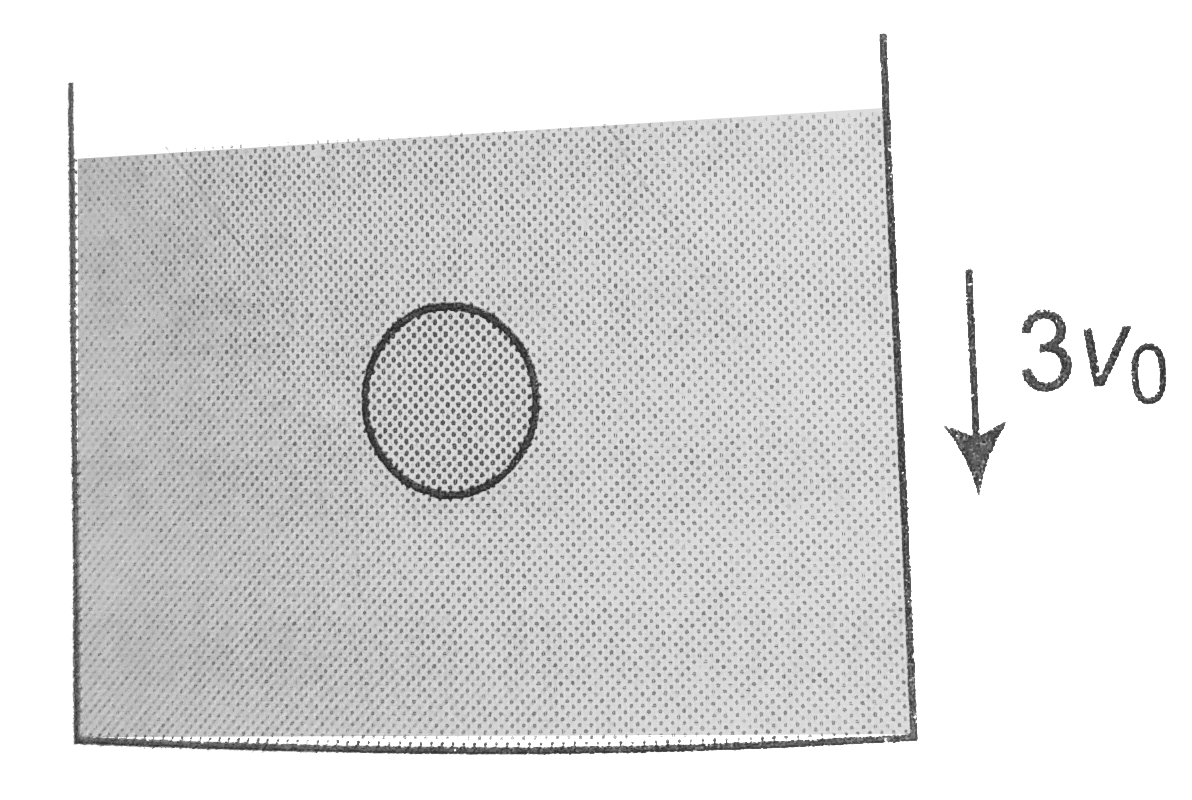A sphere of brass released in a long liquid column attains a terminal speed v0. If the terminal speed is attained by a sphere of marble of the same radius and released in the same liquid is nv0, then the value of n will be (Given: The specific gravities of brass, marble and liquid are 8.5,2.5 and 0.8, respectively)
517
1777
131
175
The correct Answer is:B
To find the value of n in the problem, we need to analyze the terminal velocities of the two spheres (brass and marble) in the liquid. We will use the formula for terminal velocity and the specific gravities provided.
Step 1: Understand the formula for terminal velocity
The terminal velocity vt of a sphere falling through a fluid is given by the equation:
vt=29r2(ρobject−ρliquid)gη
where:
- r is the radius of the sphere,
- ρobject is the density of the object,
- ρliquid is the density of the liquid,
- g is the acceleration due to gravity,
- η is the viscosity of the liquid.
Step 2: Identify the specific gravities and convert them to densities
Given:
- Specific gravity of brass SGbrass=8.5
- Specific gravity of marble SGmarble=2.5
- Specific gravity of liquid SGliquid=0.8
The density of a substance can be calculated using its specific gravity:
ρ=SG×ρwater
Assuming the density of water ρwater is 1000kg/m3:
- Density of brass ρbrass=8.5×1000=8500kg/m3
- Density of marble ρmarble=2.5×1000=2500kg/m3
- Density of liquid ρliquid=0.8×1000=800kg/m3
Step 3: Write the terminal velocity equations for both spheres
For the brass sphere:
v0=29r2(8500−800)gη
For the marble sphere:
vm=29r2(2500−800)gη
Step 4: Find the ratio of the terminal velocities
We know that vm=nv0. Therefore, we can write:
vmv0=n
Substituting the expressions for vm and v0:
n=29r2(2500−800)gη29r2(8500−800)gη
Step 5: Simplify the equation
The terms 29, r2, g, and η cancel out:
n=(2500−800)(8500−800)=17007700=1777
Conclusion
Thus, the value of n is:
n=1777
The terminal velocity vt of a sphere falling through a fluid is given by the equation:
vt=29r2(ρobject−ρliquid)gη
where:
- r is the radius of the sphere,
- ρobject is the density of the object,
- ρliquid is the density of the liquid,
- g is the acceleration due to gravity,
- η is the viscosity of the liquid.
Given:
- Specific gravity of brass SGbrass=8.5
- Specific gravity of marble SGmarble=2.5
- Specific gravity of liquid SGliquid=0.8
ρ=SG×ρwater
Assuming the density of water ρwater is 1000kg/m3:
- Density of brass ρbrass=8.5×1000=8500kg/m3
- Density of marble ρmarble=2.5×1000=2500kg/m3
- Density of liquid ρliquid=0.8×1000=800kg/m3
For the brass sphere:
v0=29r2(8500−800)gη
vm=29r2(2500−800)gη
We know that vm=nv0. Therefore, we can write:
vmv0=n
Substituting the expressions for vm and v0:
n=29r2(2500−800)gη29r2(8500−800)gη
The terms 29, r2, g, and η cancel out:
n=(2500−800)(8500−800)=17007700=1777
Thus, the value of n is:
n=1777
Topper's Solved these Questions
- PROPERTIES OF SOLIDS AND FLUIDSBOOK - CENGAGE PHYSICS ENGLISHCHAPTER - PROPERTIES OF SOLIDS AND FLUIDSEXERCISE - Multiple Correct
17 Videos
- PROPERTIES OF SOLIDS AND FLUIDSBOOK - CENGAGE PHYSICS ENGLISHCHAPTER - PROPERTIES OF SOLIDS AND FLUIDSEXERCISE - Assertion- Reasoning
13 Videos
- PROPERTIES OF SOLIDS AND FLUIDSBOOK - CENGAGE PHYSICS ENGLISHCHAPTER - PROPERTIES OF SOLIDS AND FLUIDSEXERCISE - Subjective
16 Videos
- NEWTON'S LAWS OF MOTION 2BOOK - CENGAGE PHYSICS ENGLISHCHAPTER - NEWTON'S LAWS OF MOTION 2EXERCISE - Integer type
1 Videos
- RIGID BODY DYNAMICS 1BOOK - CENGAGE PHYSICS ENGLISHCHAPTER - RIGID BODY DYNAMICS 1EXERCISE - Integer
11 Videos
Similar Questions
A sphere of radius R is gently dropped into liquid of viscosity η in a vertical uniform tube. It attains a terminal velocity v. Another sphere of radius 2R when dropped into the same liquid, will attain its teriminal velocity.
View SolutionA lead sphere of 1.0mm diameter and relative density 11.20 attains a terminal velocity of 0.7cms−1 in a liquid of relative density 1.26.
What is the value of the Reynolds number?
View SolutionA solid sphere moves at a terminal velocity of 20ms−1 in air at a place where g=9.8ms−2. The sphere is taken in a gravity free hall having air at the same pressure and pushed down at a speed of 20ms−1
View SolutionThe terminal speed of a sphere of gold of density 22.5 kg/m3 is 40 cm/s in a viscous liquid of density 2.5 kg/m3 Find the terminal speed of a sphere of aluminium of density 15.5 kg/m3 of same size in same liquid.
View SolutionThe resistance of metal is given by V=IR, The voltage in the resistance is V=(8±0.5)V and current in the resistance is I=(2±0.2)A, the value fo resistance with its percentage error is
View SolutionThe terminal speed of a sphere of gold (density = 19.5 kg m−3) is 0.2 ms−1 in a viscous liquid (density = 1.5 kg m−3). Then, the terminal speed of a sphere of silver (density = 10.5 kg m−3) of the same size in the same liquid is
View SolutionA lead sphere of 1.0mm diameter and relative density 11.20 attains a terminal velocity of 0.7cms−1 in a liquid of relative density 1.26.
Determine the coefficient of dynamic viscosity of the liquid.
View Solution
A container filled with viscous liquid is moving vertically downwards with constant speed 3v0. At the instant shown, a sphere of radius r is moving vertically downwards (in liquid) has speed v0. The coefficient of viscosity is η. There is no relative motion between the liquid and the container. Then at the shoen instant, The magnitude of viscous force acting on sphere is
View SolutionWith what terminal velocity will an air bubble of radius 0.2 mm. rise in a liquid of viscosity 0.15Nsm−2 and specific gravity 0.9 ? Density of air1.3kgm−3
View SolutionA spherical body of radius R is allowed to roll down on an incline with out slipping and it recheas with a speed v0 at the bottom. The incline is then made smooth by waxing and the body is allowed top slide without rolling and now the speed attained is 54v0 The radius of gyration of the body about an axis passing through the centre is
View Solution
